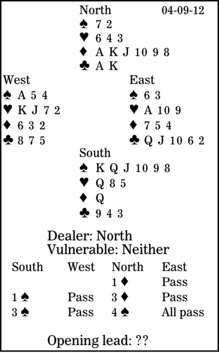Bridge column, April 9: Should defense be active or passive?

Bridge defense is difficult. It comes in two forms: active (explosive) and passive (quiet). When active, you try to establish and cash the tricks needed to defeat the contract. When passive, you sit on the couch reading the newspaper, waiting for the declarer to knock on your door with tricks for you -- what a treat!
How do you judge when to be active or passive?
First, listen to the bidding. If it sounds as though the opponents have ample values for their contract, you must fight to get your tricks early.
In this deal, what should West lead against four spades?
Following North's jump-rebid, South's three spades promises six or more spades and is game-forcing. North is close to a four-club advance control-bid (cue-bid), which would show a very good raise to four spades, but having only two trumps makes his hand fractionally too weak.
The bidding is on the strong side, so West should lead the aggressive heart two.
Now the defenders take three hearts and one spade for down one.
Note that after a passive club or low-spade lead, declarer cruises home with an overtrick.
** ** **
COPYRIGHT: 2012, UNITED FEATURE SYNDICATE
DISTRIBUTED BY UNIVERSAL UCLICK FOR UFS

